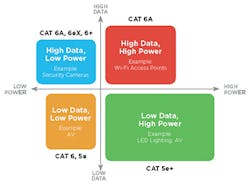Latest from Network Transformation/Edge Compute/IoT/URLLC/Automation/M2M
Extending Power-Over-Ethernet With Optical Fiber
Today’s buildings are smarter than ever before, integrating a variety of intelligent technologies to control our lighting, our climate, and our security. The prevalence of these intelligent devices in the ever-expanding Internet of Things creates a demand for cabling systems that can not only support high power and bandwidth requirements, but do so at extended lengths, and in a variety of in-building and outdoor environments.
Power-over-Ethernet (PoE), lauded for its efficiency and versatility, has fast become that cabling solution. Increasingly, building managers, IT professionals, and contractors rely on PoE cabling to supply power and data to various devices throughout their enterprise spaces.
Yet Power-over-Ethernet has its limits in terms of distance, specifically those defined by IEEE standards 802.3af and 802.3at as they apply to copper twisted-pair cables. Given these limitations, designers and suppliers of cabling solutions, as well as those who install and manage intelligent devices and their respective networks, are devising new ways to extend PoE beyond those limits utilizing optical fiber technology.
What Is Power-over-Ethernet?
PoE is a means of carrying both power and data to a device over copper communications cabling. This is accomplished by running a twisted-pair copper cable, such as a Category 5e cable, from a device to a mid-span or endpoint, where the cable can be connectorized using standard RJ-45 or similar modular connectors. While power and data are carried over the same physical channels, there is no interference between them because the power is direct current (DC) and the data is run on top of the DC voltage at frequencies ranging from 10 MHz (Category 3) to 500 MHz (Category 6A).
This chart illustrates the relative size of each market segment utilizing PoE.
PoE was first introduced by Cisco in 2000 to support their newly deployed Voice-over-Internet-Protocol (VoIP) services. PoE was an obvious backbone for VoIP technology because it was not only able to meet the high-bandwidth requirements of VoIP, but was also able to provide low-voltage power (10 W) to their VoIP devices. In 2003, the IEEE published the first PoE standard, 802.3af, which allowed 12.95 W of power to be available to the device.
Initially, PoE was essentially limited to this particular application, as most other devices that required both power and data communications in order to operate, such as digital security cameras, required more power than a two-pair copper cable could provide at the time. Recognizing the need for more power, the IEEE released the 802.3at standard that allows up to four-pair copper cables to meet, and in some cases exceed the minimum power requirements of these types of devices; currently, the IEEE is developing another standard — 802.3bt — that would further increase the amount of power copper cables can carry. Depending on the design and specification, category cables can now provide up to 100 Watts of power to a device, as well as support 10 Gigabit Ethernet.
Why Choose It?
Historically, it was common for technology that required both power and data, such as digital security cameras, to be supported by a combination of power and communications cabling. This installation model was both inefficient and costly as it required 2 distinct cable runs as well as 2 separate contractors for the installation: 1 for communications cable and the other for electrical. Devices were also prohibited from reaching too far away from their power supply, which posed a problem for devices like digital security cameras that often need to be located in remote, hard-to-reach locations where there is no direct access to an AC line or outlet.
This chart illustrates the distance limits of PoE compared to PoE + Fiber.
With PoE, these challenges are mitigated. Its ability to carry both DC power and data communications directly to and from a device allows that device more freedom of location, as it no longer needs to be tethered to an AC power source. It can also drastically reduce the cost of labor and materials by eliminating the need for a second cable run dedicated to carrying electrical power, and the need for an electrical contractor to install that cable.
Furthermore, PoE is significantly more efficient at powering a device than the traditional two-cable model. A 2013 study conducted by the IEEE found that Power-over-Ethernet was twice as efficient at distributing power as traditional electrical cabling, reducing the power lost in the channel by at least half.1
Recently, the considerable growth of the Internet of Things and the sheer volume of interconnected, data-driven devices within an enterprise space has sparked more interest in PoE cabling. In 2014 alone, PoE saw an uptake of 80% in VoIP applications. In the same year, a reported 30% of CCTVs, 20% of access controls and Wi-Fi access points, and 10% of lighting were powered by PoE.2
For building managers, IT professionals and contractors tasked with installing and managing possibly hundreds of intelligent devices, PoE offers a simple solution. Not only does it provide more efficient power and data throughput to the device compared to traditional cable setups, and a potential for cost savings as a result, but it also allows for a variety of digital devices placed throughout an environment to be powered and controlled utilizing a single communications network.
However, PoE is not without its limits; one in particular, that of distance, is of critical importance, as data transmission over twisted-pair copper cables cannot exceed a maximum length of 100 meters. This can be a real challenge for someone interested in utilizing PoE throughout an enterprise space, or even outside that space, especially when the type and quantity of intelligent digital devices, as well as the size of the environments in which they are installed, continues to grow rapidly.
What Does Optical Fiber Bring to Power-over-Ethernet?
The limits of copper PoE cabling have led many to ask if optical fiber can pick up where copper leaves off, or at the very least, aid in extending the data transmission of copper cable beyond its 100 meter limits. And the answer is: yes.
Recent research at the University of Electro-Communications in Japan conducted by a team led by Motoharu Matsuura demonstrated that an optical fiber cable system is capable of sending up to 60 watts over a 300 meter distance.3 Unfortunately, it took 6 multimode fibers to accomplish this. Clearly, the technology is not yet available to be able to send both power and data down an optical fiber.
It is possible, however, to use standard copper stranded conductors and optical fibers in the same hybrid or composite cable to accomplish this task, and there are a number of advantages to this approach.
Advantage #1: One has the ability to select a stranded wire gauge size that is appropriate for the distance, voltage, and power requirement of the end device. Wire gauges typically range from 18 AWG to as large as 12 AWG, but even larger gauges are possible. This allows devices to be placed much further than the 100 meters allowed by the PoE++ specification. In addition, there are limits to the wire gauge used in twisted pair cables, with the largest size being 22 AWG. This limits the cross sectional area — which determines resistance, voltage drop, and current carrying capacity — to 0.6426 mm². The larger the cross sectional area, the lower the resistance and voltage drop and the higher the current carrying capacity. For a 16 AWG wire, the cross section is 1.29 mm² — 29% larger than 22 AWG, equating to a significant increase in its ability to carry power.
Advantage #2: The use of fiber has the obvious advantages of transmission distance, bandwidth and resistance to electrical noise. One may also choose from a variety of fiber types in order to better suit the needs of the end device, whether it’s the end device itself or an optical-to-electrical media converter.
Since distances as long as 1,000 meters are now accessible, the number and type of devices that can be addressed, and the environments in which they can be installed, increases as well. For example, security cameras are now an easy installation in outdoor environments, such as parking lots and decks and atop buildings. Highway cameras monitoring traffic can now send high resolution video back to the central office. Sensing devices used in public transit systems can be placed along transport lines improving the reliability and data throughput of the systems. Hybrid fiber cables are also being used to supply LTE and GPS remote radio heads in a variety of environments, from enterprise spaces to cell towers.
That said, using optical fiber to extend PoE is not without its challenges and limits either. While hybrid copper/fiber cables may be ready to deploy in the aforementioned applications, the hardware may not be as evolved. In the case of security cameras, few are equipped with optical fiber ports on the device itself, thus utilizing PoE in this application requires an additional media converter. While this is not necessarily a deal-breaker, it can be cumbersome, especially in installations where multiple media converters are required for multiple devices.
The Future of PoE and Fiber
Despite the challenges of implementing optical fiber in PoE applications, the future of this technology is anything but closed. "These challenges we are seeing now regarding optical fiber in PoE applications are temporary, and will soon be overcome by the need for a simple solution for extending PoE," says Dr. Paul Neveux, Director of Global Product Management for Premises Fiber products at Superior Essex. "Eventually, designers and manufacturers of PoE devices, especially those that are used in outdoor environments where the 100 meter limits of copper are often exceeded, will begin to include optical fiber ports on the device itself, reducing the need for additional supporting hardware."
Looking at the bigger picture, the ability to extend PoE with powered optical fiber cable opens up tremendous possibilities in terms of its overall impact on the IoT. As the Internet of Things continues to expand, there are endless cable applications. From unique four-pair cables to suit a variety of bandwidth and power requirements, to hybrid fiber and copper cables.
The bottom line is this: as our daily environments are becoming more intelligent, and more widely integrated into the IoT, our cabling systems must evolve to support the high level of efficiency and interoperability those environments require.
Endnotes
1. BSRIA (2015). Convergence and Big Data: the Impact on Structured Cabling
2. BSRIA (2015). Convergence and Big Data: the Impact on Structured Cabling
3. OSA Publishing (2015). Optics Letters vol. 40.







